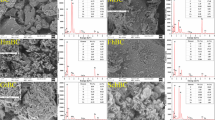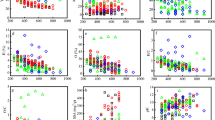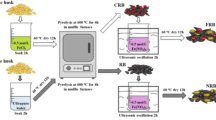Abstract
In this study, ferric chloride and sulfuric acid were used to increase the Fe-containing minerals on the biochar surface before a pyrolysis at 600 °C. The pristine and Fe-modified biochars prepared at different concentrations of sulfuric acid (50FBC and 72FBC) were characterized and analyzed, and their capacity of As(V) adsorption under various pH and ionic strength were evaluated. The results showed that the maximum adsorption capacities of As(V) calculated by the Langmuir model for 50FBC and 72FBC are 10.33 and 15.61 mg g−1, respectively, which are enhanced by 5.0 and 7.8 times compared with the pristine biochar. The higher dosage of H2SO4 (72%) used in the modification leads to a better adsorption capacity of As, especially under neutral to alkaline conditions (7.0 < pH < 10.0). It might result from the increased amounts of Fe-containing minerals formed on the biochar surface, and the enriched functional groups such as phenolic hydroxyl and carboxyl, resulting in the resistance to alkaline conditions. Overall, the Fe-modified biochar, especially 72FBC, had good potential as an environmentally friendly adsorbent for removing As from contaminated water under a wider pH range.







Similar content being viewed by others
Availability of data and materials
The authors declare that all data and materials supporting the results of this study are available within the article.
References
Abbas Y, Majeed S, Ali S, Ahmad HB, Akhtar N, Yokota H (2018) Design of gravel-sand filter for arsenic removal: a case study of Muzaffargarh District in Pakistan. Water Environ Res 90:2106–2113
Ahmad M, Rajapaksha AU, Lim JE, Zhang M, Bolan N, Mohan D, Vithanage M, Lee SS, Ok YS (2014) Biochar as a sorbent for contaminant management in soil and water: a review. Chemosphere 99:19–33
Alqadami AA, Naushad M, ALOthman ZA, Alsuhybani M, Algamdi M (2019) Excellent adsorptive performance of a new nanocomposite for removal of toxic Pb(II) from aqueous environment: adsorption mechanism and modeling analysis. J Hazard Mater 389, 121896
Amen R, Bashir H, Bibi I, Shaheen SM, Niazi NK, Shahid M, Hussain MM, Antoniadis V, Shakoor MB, Al-Solaimani SG, Wang H, Bundschuh J, Rinklebe J (2020) A critical review on arsenic removal from water using biochar-based sorbents: the significance of modification and redox reactions. Chem Eng J 396:125195
Arabi Z, Rinklebe J, El-Naggar A, Hou D, Sarmah AK, Moreno-Jimenez E (2021) (Im)mobilization of arsenic, chromium, and nickel in soils via biochar: a meta-analysis. Environ Pollut 286:117199
Beesley L, Marmiroli M (2011) The immobilisation and retention of soluble arsenic, cadmium and zinc by biochar. Environ Pollut 159:474–480
Beesley L, Moreno-Jimenez E, Gomez-Eyles JL, Harris E, Robinson B, Sizmur T (2011) A review of biochars’ potential role in the remediation, revegetation and restoration of contaminated soils. Environ Pollut 159:3269–3282
Beiyuan J, Tsang DCW, Ok YS, Zhang W, Yang X, Baek K, Li XD (2016) Integrating EDDS-enhanced washing with low-cost stabilization of metal-contaminated soil from an e-waste recycling site. Chemosphere 159:426–432
Beiyuan J, Awad YM, Beckers F, Tsang DCW, Ok YS, Rinklebe J (2017a) Mobility and phytoavailability of As and Pb in a contaminated soil using pine sawdust biochar under systematic change of redox conditions. Chemosphere 178:110–118
Beiyuan J, Li J, Tsang DCW, Wang L, Poon CS, Li XD, Fendorf S (2017b) Fate of arsenic before and after chemical-enhanced washing of an arsenic-containing soil in Hong Kong. Sci Total Environ 599-600:679–688
Benis KZ, Damuchali AM, Soltan J, McPhedran KN (2020) Treatment of aqueous arsenic - a review of biochar modification methods. Sci Total Environ 739:139750
Bolan N et al (2021) Multifunctional applications of biochar beyond carbon storage. Int Mater Rev 67:150–200
Chakraborti D, Rahman MM, Das B, Nayak B, Pal A, Sengupta MK, Hossain MA, Ahamed S, Sahu M, Saha KC, Mukherjee SC, Pati S, Dutta RN, Quamruzzaman Q (2013) Groundwater arsenic contamination in Ganga-Meghna-Brahmaputra plain, its health effects and an approach for mitigation. Environ Earth Sci 70:1993–2008
Chen B, Chen Z, Lv S (2011) A novel magnetic biochar efficiently sorbs organic pollutants and phosphate. Bioresour Technol 102:716–723
Chen H, Gao Y, El-Naggar A, Niazi NK, Sun C, Shaheen SM, Hou D, Yang X, Tang Z, Liu Z, Hou H, Chen W, Rinklebe J, Pohorely M, Wang H (2022) Enhanced sorption of trivalent antimony by chitosan-loaded biochar in aqueous solutions: characterization, performance and mechanisms. J Hazard Mater 425:127971
Cui JL, Zhao YP, Li JS, Beiyuan J, Tsang DCW, Poon CS, Chan TS, Wang WX, Li XD (2018) Speciation, mobilization, and bioaccessibility of arsenic in geogenic soil profile from Hong Kong. Environ Pollut 232:375–384
Das A, Mondal S (2021) Geomorphic controls on shallow groundwater arsenic contamination in Bengal basin, India. Environ Sci Pollut Res 28:42177–42195
El-Naggar A, Shaheen SM, Hseu ZY, Wang SL, Ok YS, Rinklebe J (2019) Release dynamics of As, Co, and Mo in a biochar treated soil under pre-definite redox conditions. Sci Total Environ 657:686–695
El-Naggar A, Chang SX, Cai Y, Lee YH, Wang J, Wang SL, Ryu C, Rinklebe J, Sik Ok Y (2021) Mechanistic insights into the (im)mobilization of arsenic, cadmium, lead, and zinc in a multi-contaminated soil treated with different biochars. Environ Int 156:106638
Fan J, Xu X, Ni Q, Lin Q, Fang J, Chen Q, Shen X, Lou L (2018) Enhanced As (V) removal from aqueous solution by biochar prepared from iron-impregnated corn straw. J Chem 2018:5137694
Ghosh M, Pal DK, Santra SC (2020) Spatial map** and modeling of arsenic contamination of groundwater and risk assessment through geospatial interpolation technique. Environ Dev Sustain 22:2861–2880
Guo J, Yan C, Luo Z, Fang H, Hu S, Cao Y (2019) Synthesis of a novel ternary HA/Fe-Mn oxides-loaded biochar composite and its application in cadmium(II) and arsenic(V) adsorption. J Environ Sci 85:168–176
He R, Peng Z, Lyu H, Huang H, Nan Q, Tang J (2018) Synthesis and characterization of an iron-impregnated biochar for aqueous arsenic removal. Sci Total Environ 612:1177–1186
Herath I, Vithanage M, Bundschuh J, Maity JP, Bhattacharya P (2016) Natural arsenic in global groundwaters: distribution and geochemical triggers for mobilization. Curr Pollut Rep 2:68–89
Ippolito JA, Cui L, Kammann C, Wrage-Mönnig N, Estavillo JM, Fuertes-Mendizabal T, Cayuela ML, Sigua G, Novak J, Spokas K, Borchard N (2020) Feedstock choice, pyrolysis temperature and type influence biochar characteristics: a comprehensive meta-data analysis review. Biochar 2:421–438
Joseph T, Dubey B, McBean EA (2015) Human health risk assessment from arsenic exposures in Bangladesh. Sci Total Environ 527:552–560
Li JS, Wang L, Tsang DCW, Beiyuan J, Poon CS (2017) Dynamic leaching behavior of geogenic As in soils after cement-based stabilization/solidification. Environ Sci Pollut Res Int 24:27822–27832
Liang T, Li L, Zhu C, Liu X, Li H, Su Q, Ye J, Geng B, Tian Y, Sardar MF, Huang X, Li F (2020) Adsorption of As(V) by the novel and efficient adsorbent cerium-manganese modified biochar. Water 12:2720
Lin L, Qiu W, Wang D, Huang Q, Song Z, Chau HW (2017) Arsenic removal in aqueous solution by a novel Fe-Mn modified biochar composite: Characterization and mechanism. Ecotoxicol Environ Saf 144:514–521
Lin MF, Nguyen NT, Chang CT, Chen PH (2019) Preparation of Fe-SBC from urban sludge for organic and inorganic arsenic removal. J Nanosci Nanotechnol 19:2658–2663
Liu J, Ren S, Cao J, Tsang DCW, Beiyuan J, Peng Y, Fa F, She J, Yin M, Shen N, Wang J (2020) Highly efficient removal of thallium in wastewater by MnFe2O4-biochar composite. J Hazard Mater 401:123311
Liu L, Zhao J, Liu X, Bai S, Lin H, Wang D (2021) Reduction and removal of As(V) in aqueous solution by biochar derived from nano zero-valent-iron (nZVI) and sewage sludge. Chemosphere 277:130273
Ohtsubo A (2018) Pollution and chronic arsenic poisoning associated with the operation of former Toroku Mine in Takachiho Town, Miyazaki Prefecture. Nihon Eiseigaku Zasshi 73:275–276
Podgorski J, Berg M (2020) Global threat of arsenic in groundwater. Science 368:845–850
Rabbani U, Mahar G, Siddique A, Fatmi Z (2017) Risk assessment for arsenic-contaminated groundwater along River Indus in Pakistan. Environ Geochem Health 39:179–190
Schreiber ME, Simo JA, Freiberg PG (2000) Stratigraphic and geochemical controls on naturally occurring arsenic in groundwater, eastern Wisconsin, USA. Hydrogeol J 8:161–176
Siddiq OM, Tawabini BS, Soupios P, Ntarlagiannis D (2022) Removal of arsenic from contaminated groundwater using biochar: a technical review. Int J Environ Sci Technol 19:651–664
Tang L, Yu J, Pang Y, Zeng G, Deng Y, Wang J, Ren X, Ye S, Peng B, Feng H (2018) Sustainable efficient adsorbent: alkali-acid modified magnetic biochar derived from sewage sludge for aqueous organic contaminant removal. Chem Eng J 336:160–169
Vithanage M, Herath I, Joseph S, Bundschuh J, Bolan N, Ok YS, Kirkham MB, Rinklebe J (2017) Interaction of arsenic with biochar in soil and water: a critical review. Carbon 113:219–230
Wang S, Gao B, Li Y, Mosa A, Zimmerman AR, Ma LQ, Harris WG, Migliaccio KW (2015) Manganese oxide-modified biochars: preparation, characterization, and sorption of arsenate and lead. Bioresour Technol 181:13–17
Wang J, Wang L, Wang Y, Tsang DCW, Yang X, Beiyuan J, Yin M, **ao T, Jiang Y, Lin W, Zhou Y, Liu J, Wang L, Zhao M (2021) Emerging risks of toxic metal(loid)s in soil-vegetables influenced by steel-making activities and isotopic source apportionment. Environ Int 146:106207
Wen Z, Zhang Y, Cheng G, Wang Y, Chen R (2019) Simultaneous removal of As(V)/Cr(VI) and acid orange 7 (AO7) by nanosized ordered magnetic mesoporous Fe-Ce bimetal oxides: Behavior and mechanism. Chemosphere 218:1002–1013
WHO (2017) Guidelines for drinking-water quality, 4th edn. World Health Organization, Geneva
Xu L, Shu Z, Feng L, Zhou J, Li T, Zhao Z, Wang W (2022) Fresh biomass derived biochar with high-load zero-valent iron prepared in one step for efficient arsenic removal. J CleanProd 352:131616
Yang X, Liu J, McGrouther K, Huang H, Lu K, Guo X, He L, Lin X, Che L, Ye Z, Wang H (2016) Effect of biochar on the extractability of heavy metals (Cd, Cu, Pb, and Zn) and enzyme activity in soil. Environ Sci Pollut Res Int 23:974–984
Zhang F, Wang X, **onghui J, Ma L (2016) Efficient arsenate removal by magnetite-modified water hyacinth biochar. Environ Pollut 216:575–583
Zhou Y, Wang J, Wei X, Ren S, Yang X, Beiyuan J, Wei L, Liu J, She J, Zhang W, Liu Y, **ao T (2021) Escalating health risk of thallium and arsenic from farmland contamination fueled by cement-making activities: a hidden but significant source. Sci Total Environ 782:146603
Zhu T, Zhang Y, Chen Y, Liu J-L, Song X-L (2022) Synthesis of novel hydrated ferric oxide biochar nanohybrids for efficient arsenic removal from wastewater. Rare Metals 41:1677–1687
Funding
The authors appreciate the financial support by the Joint Fund of Basic and Applied Basic Research Fund of Guangdong Province, China (2019A1515110927), the National Natural Science Foundation for Young Scientists of China (42007142), and the Key Scientific and Technological Project of Foshan City (2120001008392). Wenbing Yuan acknowledges the Characteristic Innovation Research Project of University Teachers (2020XCC08) for financial support.
Author information
Authors and Affiliations
Contributions
**gzi Beiyuan, Fuguo Yang, Wenbing Yuan, and Hailong Wang contributed to the study conception and design. Material preparation, data collection, and analysis were performed by Man Xu, Yiyin Qin, Qiqi Huang, Hai** Li, Wusen Chen, **aoying Wang, and Shifei Wang. The first draft of the manuscript was written by Man Xu and Yiyin Qin; all authors commented on the manuscript. All authors read and approved the final manuscript.
Corresponding author
Ethics declarations
Ethical approval
Not applicable.
Consent to participate
Not applicable.
The authors all agreed to participate and publish our data here.
Consent to publish
Not applicable. The authors all agreed to participate and publish our data here.
Competing interests
The authors declare no competing interests.
Additional information
Responsible Editor: Zhihong Xu
Publisher’s note
Springer Nature remains neutral with regard to jurisdictional claims in published maps and institutional affiliations.
Rights and permissions
Springer Nature or its licensor holds exclusive rights to this article under a publishing agreement with the author(s) or other rightsholder(s); author self-archiving of the accepted manuscript version of this article is solely governed by the terms of such publishing agreement and applicable law.
About this article
Cite this article
Xu, M., Qin, Y., Huang, Q. et al. Arsenic adsorption by different Fe-enriched biochars conditioned with sulfuric acid. Environ Sci Pollut Res 30, 16398–16407 (2023). https://doi.org/10.1007/s11356-022-23123-4
Received:
Accepted:
Published:
Issue Date:
DOI: https://doi.org/10.1007/s11356-022-23123-4




